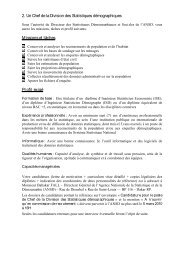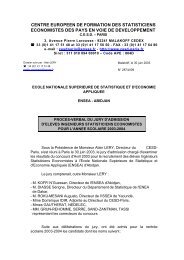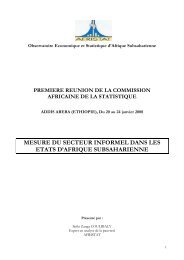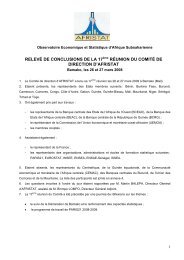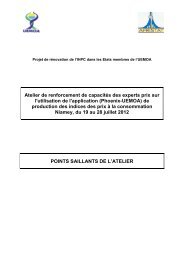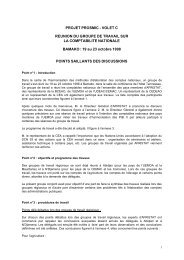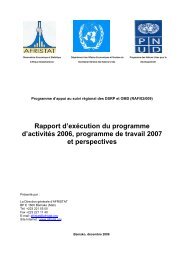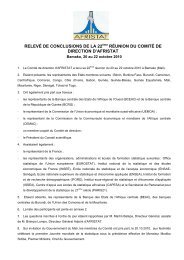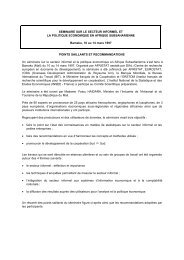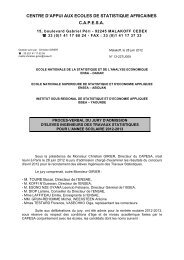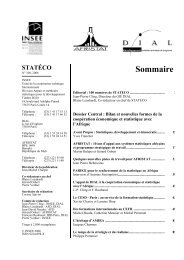Global Purchasing Power Parities and Real Expenditures - Afristat
Global Purchasing Power Parities and Real Expenditures - Afristat
Global Purchasing Power Parities and Real Expenditures - Afristat
Create successful ePaper yourself
Turn your PDF publications into a flip-book with our unique Google optimized e-Paper software.
Glossary 205in nonmarket production that are controlled <strong>and</strong> mainlyfinanced by government units or social security funds. Alsoreferred to as “government.”Gerschenkron effect. Applicable only to aggregation methodsthat use either a reference price structure (that is, eachcountry’s quantities are valued by a uniform set of prices)or a reference volume structure (that is, each country’sprices are used to value a uniform set of quantities) to comparecountries. For methods employing a reference pricestructure, a country’s share of total GDP (that is, the totalfor the group of countries being compared) will rise as thereference price structure becomes less characteristic of itsown price structure. For methods employing a referencevolume structure, a country’s share of total GDP will fallas the reference volume structure becomes less characteristicof its own volume structure. The Gerschenkron effectarises because of the negative correlation between prices<strong>and</strong> volumes.GK method (Geary-Khamis method). An average-pricemethod to compute PPPs <strong>and</strong> real final expenditures abovethe basic heading. It entails valuing a matrix of quantities,using a vector of international prices. The vector is obtainedby averaging national prices across participating countriesafter they have been converted to a common currency withPPPs <strong>and</strong> weighted by quantities. The PPPs are obtainedby averaging within participating countries the ratios ofnational <strong>and</strong> international prices weighted by expenditure.The international prices <strong>and</strong> the PPPs are defined by a systemof interrelated linear equations that require solvingsimultaneously. The GK method produces PPPs that aretransitive <strong>and</strong> real final expenditures that are additive. Ithas a number of disadvantages. One is that a change in thecomposition of the group can change significantly the internationalprices, as well as the relationships between countries.Another is that the real final expenditures are subjectto the Gerschenkron effect, which can be large. GK resultsare considered to be better suited to the analysis of price<strong>and</strong> volume structures across countries.Goods. Physical objects for which a dem<strong>and</strong> exists, overwhich ownership rights can be established, <strong>and</strong> whoseownership can be transferred from one institutional unit toanother by engaging in transactions on the market. They arein dem<strong>and</strong> because they may be used to satisfy the needs orwants of households or the community or used to produceother goods or services.Government final consumption expenditure. Expenditure,including imputed expenditure, incurred by general governmenton both individual consumption goods <strong>and</strong> services<strong>and</strong> collective consumption services.Gross fixed capital formation. Measured by the total valueof a producer’s acquisitions, less disposals, of fixed assetsduring the accounting period, plus certain additions to thevalue of nonproduced assets (such as subsoil assets or majorimprovements in the quantity, quality, or productivity ofl<strong>and</strong>) realized by the productive activity of institutionalunits.Health. Includes expenditures by households on medicalproducts, appliances <strong>and</strong> equipment, outpatient services,<strong>and</strong> hospital services; also includes expenditures by governmenton health benefits <strong>and</strong> reimbursements <strong>and</strong> on productionof health services.Household. A small group of persons who share the sameliving accommodation; who pool some, or all, of theirincome <strong>and</strong> wealth; <strong>and</strong> who consume certain types ofgoods <strong>and</strong> services collectively, mainly food <strong>and</strong> housing. Ahousehold can consist of only one person.Household final consumption expenditure. Expenditure,including imputed expenditure, incurred by residenthouseholds on individual consumption goods <strong>and</strong> services,including those sold at prices that are not economicallysignificant.Housing, water, electricity, gas, <strong>and</strong> other fuels. Includesexpenditures on actual <strong>and</strong> imputed rentals for housing;maintenance <strong>and</strong> repair of the dwellings; water supply <strong>and</strong>services related to the dwellings; <strong>and</strong> electricity, gas, <strong>and</strong>other fuels.ICP (International Comparison Program). Started as aresearch project in the 1960s with the ultimate goal of



